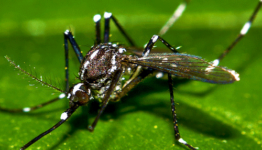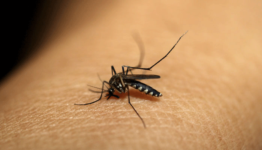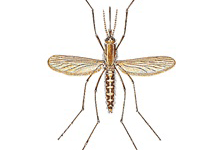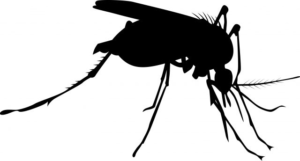
- “Mosquito” originated from the Spanish meaning of the word “little fly”. This origination began in Australia, New Zealand and Africa around the 16th century. “Mozzies” are sometimes used to replace “mosquitoes”.
- With about 175 different species existing in the United States, there over three thousand five hundred mosquito species present on planet Earth. The commonest species include the Aedes aegypti, Anopheles quadrimaculatus and Culex pipiens, Aedes aegyti, and the Aedes albopictus (tiger mosquito of Asian origin). Malaria is transmitted by the Anopheles mosquitoes while various types of encephalitis are transmitted by the other species.
- Mosquitoes emerged around the second Mesozoic era .Evidences have so far estimated their period of existence up to 210 million years. They have also been referenced throughout history by people like Aristotle (around 300 B.C) and Sidonius Appolinaris (around 467 B.C).
- The region of the United States inhabited by the least number of species of mosquito is West Virginia. The region with about 85 species (the highest) is Texas. This is followed by Florida which has 80 different species and the mountainous state which is inhabited by about 26 varying species of mosquitoes.
- In 1999, the first infection with the West Nile Virus on US soil occurred. From the diagnosis of a sick lady in Uganda, the virus was first detected by scientists. Though the first outbreak of the virus in the United States was in New York around 1999, there had been previous outbreaks in other parts of the world such as Romania, Israel and South Africa.
- About 300 eggs can be released by female mosquitoes at a go. Female mosquitoes often lay eggs more time twice in their lifespan. Their preferential breeding spots include clusters (or rafts) as deep as 2.5 centimeters of stagnant and untouched water bodies and water-logged places.
- Mosquitoes live in water for ten days after birth. Water is indispensible for the complete metamorphosis of the mosquito because it helps the eggs hatch into wrigglers (larvae) which survive on oxygen from water surface and organic materials found in standing water. Before the larvae becomes a completely metamorphosed mosquito, it first changes to pupae which is partially enclosed in a cocoon and barely feeds during this stage.
- Mosquitoes live for approximately two months. While female mosquitoes have long lifespans of about two months, their male counterparts barely live up to ten days. Species of mosquitoes that hibernate have their females live up to half a year.
- Mosquitoes sleep through cold temperatures. They external heat to survive and cannot remain active at temperatures below 50 degree centigrade. They often locate crevices, cracks and holes where they would sleep through the cold weather in anticipation of warmer temperatures (above 80 degree centigrade). Some of their females breed in extremely cold water bodies and then die. Their laid eggs are able to stay alive till the temperature increases before hatching.
- Mosquitoes possess six appendages. Just like other insects, the head of the mosquito comes with a pair of compound eyes, a pair of simple eye (ocelli), a proboscis and a pair of antennae. Their thorax equally has a pair of scaled wings attached to both sides.
- Mosquitoes possess no form of dentition. Their females penetrate the skins of their victims and locate blood vessels from which they feed with the help of the proboscis.
- Crane flies and midges have similar physical feature as the mosquitoes. While midges bite and are way smaller than an average-sized mosquito, crane flies do not bite and are way bigger than mosquitoes ( they are usually up to 7 centimeters long), but some mosquito baits often catch and kill midges.
- Mosquitoes have limited speed and distance of flight. Mosquitoes hardly fly beyond several hundred feet from their hatching spots. Their maximum distance and speed of flight are 1.5 to 3 miles per hour respectively. Only a few species such as the salt marsh has the capacity to fly a distance of 40 miles.
- Mosquitoes cannot fly above 25 feet from the ground. Only rare species can attain unbelievable heights. Himalayas which is about 8,000feet from the ground, is a typical example.
- A mosquito can have a meal of blood that is thrice its body weight. About 1.2million sucks from the body is able to drain blood from the entire human body.
- Male mosquitoes detect their mating partners by the sound emanating from the flapping of their wings. They do this by picking out flapping of higher frequency (usually up to 500 beats per second) which usually comes from their female counterparts.
- Only female mosquitoes bite. Mosquitoes survive on fruits and nectar but the females usually require blood protein for the proper development of their eggs. They rest for a few days after feeding satisfactorily on blood before they finally lay their eggs in stagnant water.
- Mosquitoes are able to pick out human breathe. They follow trails left by the carbon dioxide released by humans during respiration. They are able to detect the presence of carbon dioxide with the help of certain receptors in their antennae.
- Human sweat is mosquito menu. Some chemical odours out of about 340 produced by the human skin are appetizing to mosquitoes. Among their favorites are octenol (produced in sweat), folic acid, cholesterol and certain bacteria. They are also attracted to body lotions and perfumes.
- Mosquitoes are able to navigate to their victims with the help of body heat. Heat from the body (actually from the blood) is detected by certain heat sensors around the mouthparts of mosquitoes.
- A lot of mosquitoes feed all day long. Species in the likes of Aedes feed during the day while other species such as the Culex prefer to feed from dusk to dark.
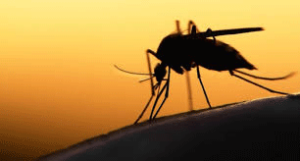
- The itchy bumps that form after a mosquito bite houses saliva. The saliva that fills these bumps contains a sort of an anti-coagulant that inhibits pain and is pumped into the skin by a second tube in the proboscis during feeding.
- Mosquitoes are only carriers of the malaria parasite. Mosquitoes transmit a number of diseases through the saliva they pump into their victims during a meal. These diseases include malaria, canine heart-worm, Nile West virus and a good number of other viruses.
- HIV cannot be passed on through a mosquito bite. The Human Immuni-deficiency Virus is digested by mosquitoes and cannot multiply in them. Therefore, the virus cannot be transmitted by mosquitoes.
- Funny enough, no animal kills bigger and faster than mosquitoes. As unserious as it might seem, the female Anopheles mosquito is the most dangerous species of mosquito because it is responsible for the transmission of malaria, a deadly disease that snuffs life out of millions of people globally every passing year. It is particularly more in Africa and it is believed that Alexander the Great was killed by the parasite.
- Wrigglers are usually wiped out by certain bacteria. Bacterium such as Bacillus thuringiensis israelensis (Bti) produces proteins that are toxic to mosquito larvae after consumption. Bti is marketed in form of tablets and powder which is injected into water bodies containing the larvae of mosquitoes.
- Insecticides are only effective against mosquitoes for a short period of time. Certain chemicals used in mosquito control such as permethrin kill mosquitoes once they make contact with it by disintegrating their nervous systems. Insecticides have no significant effect on mosquito eggs and larvae and cease to affect adult mosquitoes once there concentration reduces in a place.
- Mosquitoes are suckers for dark clothing. Dark clothing absorbs and retains heat more than lighter clothing. Since mosquitoes are attracted by heat, they tend to land more on dark-clothed sources than those of light colours.
- The best mosquito repellent so far is DEET. Out of about three repellents – picaridin, lemon-eucalyptus oil and DEET – tested and recommended by the CDC (Center for Disease Control), DEET is the best not because it covers the scent of victims or manipulates the mosquito senses but because its odour is really horrible to mosquitoes.
- Not all bats are predators to mosquitoes. Mosquitoes only make up an almost insignificant portion of a bat’s diet. The bats that feed on mosquitoes feed only on a small number of them. The purple martins for example feed only occasionally on mosquitoes but prefers constant feeding on dragonflies as well as other delectable insects.
- Dragonflies and fish are directly above mosquitoes on the food chain. It has been established that while the larvae of dragonflies feed on mosquito larvae, adult dragonflies feed on fully metamorphosed mosquitoes. For this reason, a lot of communities release dragonflies as well as their larvae into their surrounding as a measure for mosquito control. The Gambusia (a.k.a mosquitofish) is also used worldwide in mosquito control because they feed on mosquito larvae.
- Mosquito traps are capable of getting rid of a large population of mosquitoes in just a night. From a research carried out by a group of Australian health researchers, it was established that a large scale trap was effective against 17 species comprising about 45,000 mosquitoes of the feminine sex in a fortnight.
- Mosquitoes are in no way affected by bug zappers. These devices undoubtedly catch and kill a good number of both useful and dangerous insects but mosquitoes never make up to a percentage of these insects. In the same way bug zappers are ineffective on the mosquito population, traps that use electric charges have also been proven useless.



